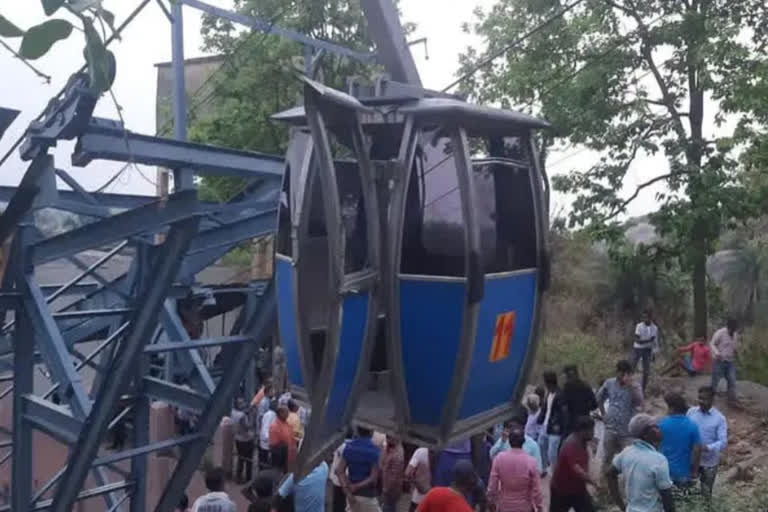Hyderabad: The rescue operation in the Trikut cable car accident in Jharkhand's Deoghar ended on Tuesday. The incident claimed three lives out of which two persons fell to their death while being airlifted. The rescue operation began on Sunday and saw the harrowing tourists being stuck mid-air for nearly 48 hours.
Here is how adventure tourism turned into a tragedy in the idyllic hills of Deoghar:
- The Trikut cable car accident took place at around 4.30 pm on Sunday when the ropeway's axle got dislodged from its socket and it stopped midway leaving about 50 persons dangling in mid-air in cable cars. The malfunction resulted in some of the trolley cars colliding with each other due to which one person died.
- The IAF was called in to join the rescue operations on Monday which started at around 7.30 am. A team of IAF Garuda commandos, along with MI-17 and MI-17 V5, were rushed to the spot for airlifting the stranded tourists. Another death took place during the rescue operation a tourist fell to his death when the safety belt of a tourist suddenly unfastened when he was being airlifted and he fell to his death.
- The rescue operation lasted for 11 hours on Monday. The NDRF also joined the rescue operation during the day. They rescued 11 stranded tourists before the Army personnel reached the spot. The Army personnel rescued 21 stranded tourists.
- The third death in the incident took place when a woman fell to her death when she was being airlifted as the rope got stuck in the ropeway. The pilot of the IAF chopper tried to untangle the rope by jerking it but failed to do so so. Then the rope broke and the woman fell into the hills.
- The rescue operation was completed on Tuesday afternoon. Expressing his grief over the incident Union Minister for State, Nityanand Rai said NDRF personnel, IAF teams and ITBF soldiers worked continuously to evacuate people safely. He also said that Central agencies had teamed up with the local administration for rescuing the trapped tourists. The rescue teams provided food, medicines, and other essential items to the stranded people.
- Deoghar District Magistrate (DM) Manjunath Bhajantri said, "The IAF rescue team provided food and water to the stranded tourists on the cable cars. Though, the target was to rescue people by the evening of April 11, but could not materialize. The demography of the Trikut hills is such that we faced hurdles to carry out rescue operations at night. On Tuesday morning, all the remaining stranded tourists were taken out of the cable cars safely."
- A Garuda commando was stuck in one of the cable cars during the rescue operations on Monday. He was airdropped to a trolley, but as darkness descended the IAF choppers had to move out from the rescue site leaving him stranded for the night.
- The first major ropeway accident happened in January 2003 in Gujarat where seven people lost their lives and 20 were injured after the three cable cars fell down.
- Four tourists, including three women and a child, were killed and 11 others seriously injured when two ropeway cars operating between Singameri and Tukver in Darjeeling hill station of West Bengal detached from the cable and plummetted downhill in July 2016 a 26-year-old fell from a cable car into the Mandakini river and lost his life. In September of the same year, a three-year-old girl fell from a trolley and died.
- On June 26, 2017, seven persons died when a tree, uprooted by strong winds, fell on the ropeway of Gulmarg Gondola and severed the lines due to which the cable car came crashing to the ground. The cable car operator described the incident as an "act of God'. On January 20, 2019, two workers died and four others suffered injuries after a cable car of the under-construction Jammu ropeway project crashed during a mock rescue drill, days before it was likely to be inaugurated by Prime Minister Narendra Modi.



